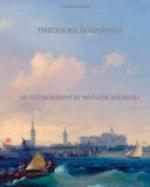Like most Americans interested in birds and books, I know a good deal about English birds as they appear in books. I know the lark of Shakespeare and Shelley and the Ettrick Shepherd; I know the nightingale of Milton and Keats; I know Wordsworth’s cuckoo; I know mavis and merle singing in the merry green wood of the old ballads; I know Jenny Wren and Cock Robin of the nursery books. Therefore I had always much desired to hear the birds in real life; and the opportunity offered in June, 1910, when I spent two or three weeks in England. As I could snatch but a few hours from a very exciting round of pleasures and duties, it was necessary for me to be with some companion who could identify both song and singer. In Sir Edward Grey, a keen lover of outdoor life in all its phases, and a delightful companion, who knows the songs and ways of English birds as very few do know them, I found the best possible guide.
We left London on the morning of June 9, twenty-four hours before I sailed from Southampton. Getting off the train at Basingstoke, we drove to the pretty, smiling valley of the Itchen. Here we tramped for three or four hours, then again drove, this time to the edge of the New Forest, where we first took tea at an inn, and then tramped through the forest to an inn on its other side, at Brockenhurst. At the conclusion of our walk my companion made a list of the birds we had seen, putting an asterisk (*) opposite those which we had heard sing. There were forty-one of the former and twenty-three of the latter, as follows:
* Thrush, * blackbird, * lark, * yellowhammer, * robin, wren, golden-crested wren, * goldfinch, * chaffinch, * greenfinch, pied wagtail, sparrow, dunnock (hedge, accentor), missel thrush, starling, rook, jackdaw, blackcap, garden warbler, * willow warbler, * chiffchaff, * wood warbler, tree-creeper, * reed bunting, * sedge warbler, coot, water hen, little grebe (dabchick), tufted duck, wood pigeon, stock dove, * turtle dove, peewit, tit (? coal-tit), * cuckoo, * nightjar, * swallow, martin, swift, pheasant, partridge.
The valley of the Itchen is typically the England that we know from novel and story and essay. It is very beautiful in every way, with a rich, civilized, fertile beauty—the rapid brook twisting among its reed beds, the rich green of trees and grass, the stately woods, the gardens and fields, the exceedingly picturesque cottages, the great handsome houses standing in their parks. Birds were plentiful; I know but few places in America where one would see such an abundance of individuals, and I was struck by seeing such large birds as coots, water hens, grebes, tufted ducks, pigeons, and peewits. In places in America as thickly settled as the valley of the Itchen, I should not expect to see any like number of birds of this size; but I hope that the efforts of the Audubon societies and kindred organizations will gradually make themselves felt until it becomes a point of honor not only with the American man, but with the American small boy, to shield and protect all forms of harmless wild life. True sportsmen should take the lead in such a movement, for if there is to be any shooting there must be something to shoot; the prime necessity is to keep, and not kill out, even the birds which in legitimate numbers may be shot.




